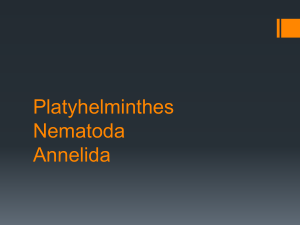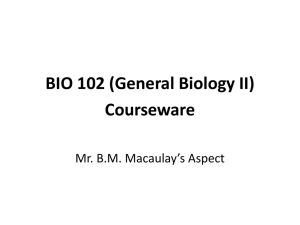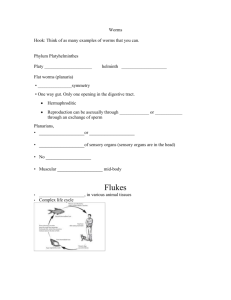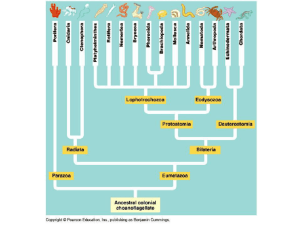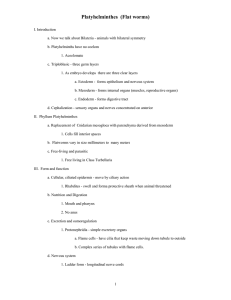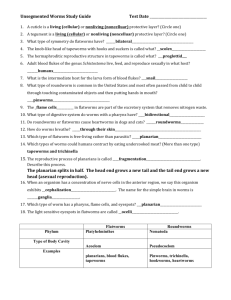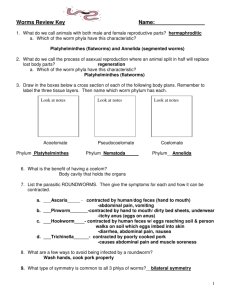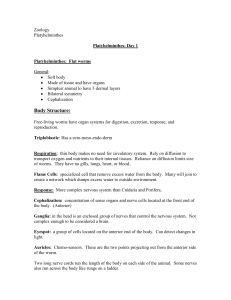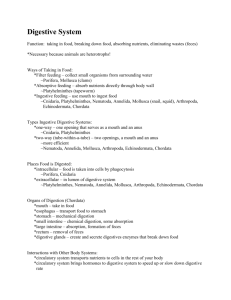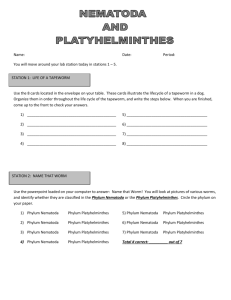BIO 102 Courseware-1
advertisement
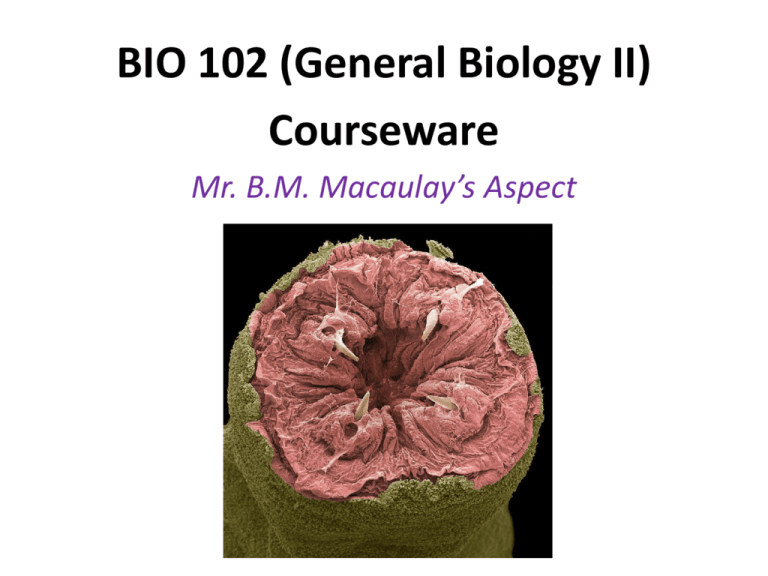
BIO 102 (General Biology II) Courseware Mr. B.M. Macaulay’s Aspect RECAP (1) Kingdom: Animalia Sub-Kingdom: Invertebrata Phyla: 1. Porifera 2. Coelentrata (Cnidaria and Ctenophora) 3. Platyhelminthes 4. Nematoda 5. Annelida 6. Arthropoda 7. Mollusca 8. Echinodermata RECAP (2) Kingdom: Animalia Sub-Kingdom: Vertebrata Phyla: * Protochordata (Usually an intermediate between Invertebrata and Vertebrata) 1. Pisces 2. Amphibians 3. Reptiles 4. Mammals 5. Aves Description and Characteristics of the Phyla: • Platyhelminthes • Nematoda • Annelida Phylum: Platyhelminthes The Flatworms General Description: PLATYHELMINTHES • From the Greek origin, ‘platy’ means flat and ‘helminthes’ means worms, hence, flat worms. • Generally, classes of flatworms either live freely in rivers, lakes, seas (for example, Planaria) or as parasitic organisms in the body of animals (for example, flukes and tapeworm). Characteristics of Platyhelminthes (1) 1. They are generally dorso-ventrally flattened. 2. They are bilaterally symmetrical. 3. Have three body layers, i.e. triploblastic, with organs and organelles. 4. Body contains no internal cavity, i.e. Acoelomate. The space between the body wall and gut are filled with parenchyma composed of loose cell masses. 5. Possesses a blind gut (i.e. it has a mouth but no anus) but well branched to transport food all over the body. THE EVOLUTION OF BODY CAVITIES Characteristics of Platyhelminthes (2) 6. Nervous system is ladder-like. It is in the form of a brain and two main longitudinal nerve cords connected at intervals by transverse commissures. 7. The reproductive system is well organized. Most of them are hermaphrodites. (Hermaphroditism is a phenomenon where both male and female sex organs are situated within the same body). 8. They feed mostly on animals and other smaller life forms. Planaria and the flame cell Characteristics of Platyhelminthes (3) 9. Flatworms generally possess nephridial tubules called protonephridia, usually distributed throughout the body. • Protonephridia consist of an external opening and a tubule that branches internally, terminating in a number of blind, bulb-shaped structures called flame bulbs, which bear tufts of cilia. • Protonephridia function as excretory and osmoregulatory organs. The Structure of Protonephridium Characteristics of Platyhelminthes (4) 10. The Body is devoid of true metameric segmentation. 11. Circulatory and respiratory systems are absent. 12. Many flat worms undergo regeneration of certain parts of their body. PLAYHELMINTHES (2) There are three broad classes in the phylum, platyhelminthes. They are: • Class: Turbellaria • Class: Trematoda • Class: Cestoda TURBELLARIA (1) 1. They are mostly free-living and primarily carnivorous. 2. They are characterized by a soft epidermis that is ciliated on the ventral surface. The movement of the cilia propels the smaller forms. 3. They possess a pair of fused cerebral ganglia which forms a rudimentary brain, with two interconnected parallel nerve cord running length of body. 4. Ocelli (simple eyes) are present in some. TURBELLARIA (2) Turbellarians are generally divided into five groups based on the different forms of their digestive cavity. They are: Acoels: have no digestive cavity. Allocoels: Sack-like or branched digestive cavity. Rhabdocoels: Straight and unbranched digestive cavity. Triclads: Possess three-branched gut. The commonest example of turbellaria, Planaria, is a triclad. Polyclads: gut sub-divided into numerous branches. Planaria (Dugesia tigrina) TREMATODA (1) 1. These are parasitic flatworms and are often referred to as Flukes. For example, Blood fluke, Liver fluke, etc. 2. They have oral suckers, sometimes supplemented by hooks, with which they attach to their vertebrate hosts. 3. Trematodes have retained the same body form and digestive cavity as the turbellarians. TREMATODA (2) 4. The entire interior of trematodes is occupied by the reproductive system; the organism is capable of producing huge numbers of offspring. 5. The are majorly hermaphrodites. For some such as S. haematobium, the female (larger) houses the male (smaller) in a gynaecophoric canal. TREMATODA (3) Trematodes can be divided into two broad groups based on the number of host: Monogenea: trematodes parasitising a single host Digenea: trematodes parasitising two or more hosts. • Monogenetic flukes spend their entire life cycle as parasites on a single host, often on the gills and skin of fish; they include no human parasites. • These flukes hold on to the fish by the use of hooks and attachment organs at the posterior end. E.g. Gyrodactylus sp. (Gill fluke). TREMATODA (4) • Digenetic flukes on the other hand, have complex life cycles involving two or more hosts. • The larval worms parasitise one or more small animals (typically snails and sometimes fishes) and the adult worms further parasitises vertebrate hosts. E.g. Schistosoma haematobium (Blood fluke) and Fasciola hepatica (Liver fluke). • In the case of S. haematobium, the larva initially parasitises a snail (Bulinus sp.) and when the adult emerges, it enters a vertebrate host (E.g. Man) to complete its life cycle causing the disease, Schistosomiasis. Schistosoma haematobium (Blood fluke) Female houses male in a gynaecophoric canal Fasciola hepatica (Liver fluke) Gyrodactylus sp. (Gill fluke) CESTODA (1) 1. Cestodes are parasitic flatforms also known as tapeworms as a result of their tape-like body structure. 2. The body of Cestodes has lost the typical turbellarian form. 3. A typical cestode body (known as strobila) consists of series of linearly arranged reproductive segments called proglottids which may be immature, mature or gravid. 4. They are mostly hermaphrodites. 5. There is no mouth or digestive system; food is absorbed through the body cuticle. CESTODA (2) 6. Adults live in the digestive tract of vertebrates, and larval forms encyst in the flesh of various vertebrates and invertebrates. 7. The tapeworm’s head called scolex, bears a crown-like rostellum and four circle of hooks/suckers which are attachment organs. 8. The body of an adult tapeworm is virtually a reproductive factory; gravid proglottids (i.e. Filled with fertilised eggs) are released with the faeces of the definitive host to resume development in the body of an intermediate host. The Scolex of the Tapeworm (Taenia solium) Tapeworm (Taenia sp.) T. Saginata vs T. solium S/ N 1. 2. Taenia saginata Taenia solium Nature of the scolex Has no Has a rostellum; rostellum; No 2 rows of spiny hook; 4 suckers. hooks (22-32); 4 suckers. Type of intermediate host Cattle Pig Phylum: Nematoda The Roundworms NEMATODA (1) General Description: • Nematodes derived their name from the Greek word, ‘Nema’, meaning, "thread" and ‘tode’ meaning, "like“, i.e. thread-like worms. • This is the second largest phylum in the animal kingdom next to the Arthropods. Members are approximately 80,000 species, of which 15,000 are parasitic. • Examples include the common roundworm of man (Ascaris lumbricoides), hookworm, Pinworm, Guinea worm, whipworm, etc. CHARACTERISTICS OF NEMATODA (1) 1. They are vermiform (worm-like), usually cylindrical in shape. 2. Triploblastic and non-segmented, with bilateral symmetry. 3. Size varies from microscopic to pencil-sized. 4. They are covered with thick cuticle, having no external cilia. 5. Body cavity is pseudocoelomate, and the fluidfilled space functions as hydrostatic skeleton. 6. They have a complete digestive system (i.e. true gut) but circulatory and respiratory organs are still lacking. CHARACTERISTICS OF NEMATODA (2) 7. Excretory system consists of one or more large gland cells opening to an excretory pore or canal system 8. Circular nerve ring with dorsal and ventral nerve cords; sense organs include phasmid and ciliated pits. 9. Sexes are usually separate (dioecious) 10. Male is smaller than the female and has a characteristic curved or bent tail. 11. The phylum contains both free-living and parasitic members. Nematode (Ascaris Sp.) – Male and female species NEMATODA (2) The phylum Nematoda is divided into two classes: • Enoplea • Chromadorea Characteristics of class Enoplea 1. Amphids pocket-like, not spiral, usually post-labial. 2. Cuticle smooth or finely striated. 3. Phasmids present or absent. NB: Amphids are slits or openings above or below the lip. Phasmids are slits or openings at the posterior region. Examples include: Trichuris trichiura, Mermis nigrescens (Grasshopper nematode parasite), etc. Characteristics of class Chromadorea 1. Pore-like or slit-like amphid apertures vary from labial pores or slits to post-labial elaborate coils and spirals. 2. Cuticle usually annulated, sometimes ornamented with projections and setae. 3. Phasmids present or absent, generally posterior. Examples include: Hookworm, pinworm, whipworm, Common round worm of man, etc. Ascaris lumbricoides (Ascariasis) Ascaris life cycle Ancylostoma duodenale (Hookworm) Hook worm disease Dracunculus medinensis (Guinea worm) Dracunculiasis Trichuris trichiura (Whipworm) Trichuris life cycle Trichuriasis Mermis nigrescens (Grasshopper nematode) Grasshopper nematode disease Enterobius vermicularis (Pin worm) Enterobius Life cycle Enterobiasis Wuchereria bancrofti (Microfilarial worm) Elephantiasis Onchocerca volvulus (Microfilarial worm) Blackfly (Simulium damnosum) Onchocerciasis Assignment I have supplied you with enough examples of parasitic nematodes; however, to complete your knowledge of nematodes, you will have to supply me with five (5) common examples of free-living (non-parasitic) nematodes before the next class. Phylum: Annelida Segmented worms ANNELIDA (1) General Description • The Annelida (segmented worms) are a medium sized phylum of more than 9,000 species of worms. • Most species prefer aquatic environments, but there are also a number of well known terrestrial species. • Only a few species of annelids are commonly known to human beings. These include the Earthworms, Ragworms, Medicinal leeches, etc. CHARACTERISTICS OF ANNELIDA (1) 1. Bilaterally symmetrical and vermiform, i.e. Worm-like. 2. They are triploblastic with 3 body layers. 3. Body cavity is a true coelom, i.e. Eucoelomates. 4. They are metamerically segmented, i.e. divided by internal septa. 5. Body possesses a true gut with mouth and anus. 6.Body possesses 3 separate sections, a prostomium, a trunk and a pygidium. CHARACTERISTICS OF ANNELIDA (2) 7. Has a true closed circulatory system. 8. Has no true respiratory organs. 9. Excretion is carried out by the nephridium in many annelids. 10.Reproduction normally sexual or hermaphroditic. 11. Feed a wide range of materials. 12. Live in most environments, i.e. Ubiquitous. 13. Has a nervous system with an anterior nerve ring, ganglia and a ventral nerve chord. THE STRUCTURE OF NEPHRIDIUM ANNELIDA (2) The phylum Annelida is currently under review and there are lingering debates on it. However, the phylum is traditionally divided into 3 broad classes: • Class Polychaeta • Class Oligochaeta • Class Hirudinea CLASS POLYCHAETA • ‘Poly’ – Many; ‘Chaeta’ – Hair-like structure. • They are predominantly marine animals and are divided ecologically into the Errantia and the Sedentaria depending on whether or not they live sedentary lives in holes or live more active lives. • The Errantia have well developed heads and complex parapodia (paddles) that they can use for swimming. • Polychaetae are hermaphrodites; A reproductive segment is often formed which dies immediately after the release of gametes. • Examples: ragworm, lugworm and bloodworm. Ragworm Bloodworm Lugworm CLASS OLIGOCHAETA • ‘Oligo’ – Few; Chaete – Hair-like structure. • Oligochaetae live in marine, freshwater and terrestrial habitats. • Generally, they have a more rounded cross-section and a less distinct head. • They are usually hermaphrodites but seldomly undergo sexual reproduction. • As adults, they possess a clitellum – an organ which looks like a bandage of skin wrapped around the anterior region of the animal. This clitellum has an important function in sexual reproduction. • Examples: Earthworm, Aelosomata worms (e.g. Aelosoma hemprichi), Branchiobdella worms (Branchiobdella astaci). Earthworm (Lumbricus terrestris) CLASS HIRUDINEA 1. Hirudinea occur in Fresh water, marine and terrestrial environments. 2. They are commonly known as leeches. 3. Leeches are well known for their blood sucking habits and their head-to-tail looping mode of locomotion. 4. They have two suckers – In most cases, one is located at the anterior (head) end of the body composed of segments 1-4 and the other at the posterior (tail) end composed of segments 25-33. 5. Medicinal leeches (Hirudo medicinalis) have been useful in treating blood circulatory illnesses. Leeches
